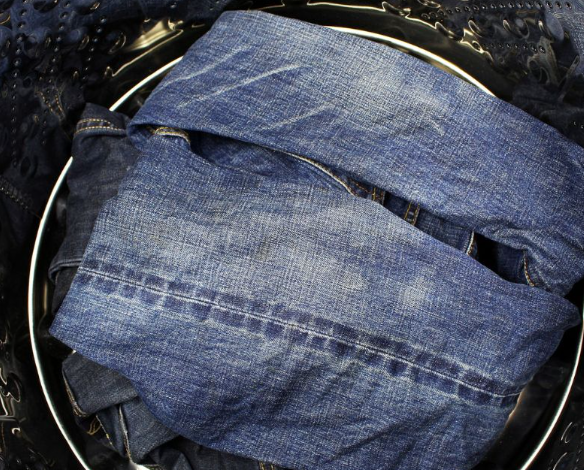
How to Care for Your Denim Collection: Washing, Drying, and Storage Tips
Denim is a versatile and durable fabric, and with the right care, it can last for years. Whether it’s your favorite pair of jeans or a timeless denim jacket, preserving its color, fit, and texture requires attention to how you wash, dry, and store your denim. With a few simple techniques, you can keep your denim looking fresh while ensuring its longevity.
Understanding Denim Fabrics
Denim is made from a sturdy cotton twill weave, known for its resilience and versatility. It comes in various weights and types, each with its own characteristics. Understanding these can help you care for your denim better:
- Lightweight Denim: Ideal for warm climates, this type is breathable and comfortable for casual wear. Despite being thinner, it holds its shape well.
- Midweight Denim: The most common type, offering a perfect balance of durability and comfort. This is the denim you likely wear most often.
- Heavyweight Denim: Heavier denim is stiffer at first but molds to your body over time. It’s highly durable and commonly used in workwear.
- Stretch Denim: Contains small amounts of spandex or elastane, making it flexible and ideal for form-fitting styles.
- Selvedge Denim: Known for its tightly woven edges, selvedge denim is durable and often considered a premium option.
Knowing your denim fabric type is essential in determining the best care methods to maintain its quality and longevity.
How to Wash Your Denim
Washing denim properly is key to maintaining its look and feel. Overwashing can cause fading and fabric degradation, so it’s important to wash sparingly and gently. Here’s how to care for your denim in the wash:
- Turn Denim Inside Out: This helps reduce abrasion on the fabric’s outer surface, preserving its color and texture.
- Use Cold Water: Wash your denim in cold water to prevent the dye from fading and the fibers from relaxing. Hot water can cause colors to bleed and fibers to weaken.
- Gentle Detergent: Choose a mild detergent free of bleach or harsh chemicals to avoid damaging the fabric.
- Avoid Overloading the Machine: Give your denim space in the washing machine to reduce friction, which can cause damage and wear.
- Hand Wash if Necessary: For extra care, hand wash your denim in cool water with a mild detergent, especially for delicate items.
Washing denim in cold water and using gentle methods helps preserve its color and texture over time.
Drying Your Denim
Proper drying is just as important as washing. Using the wrong drying methods can cause shrinkage, misshaping, and fading. Here are the best practices:
- Air Drying: The safest method for drying denim is to hang it to air dry. This prevents shrinkage and helps maintain the garment’s natural fit.
- Avoid Machine Drying: If you must use a machine, opt for the lowest heat setting and remove your denim while it’s still damp to finish air drying. This prevents excessive shrinkage and fabric stress.
- Reshape Your Denim: If your denim becomes misshapen during washing, gently lay it flat and reshape it to restore its structure.
- Dry Heavier Denim Naturally: Heavier pieces like raw denim jeans should be hung to dry for 24-48 hours to avoid distortion.
Air drying is ideal for preserving your denim’s shape and fit, especially for raw or unwashed denim.
Stain Removal Tips for Denim
Stains are inevitable, but quick action can prevent them from setting. Here’s how to deal with common stains:
- Grease and Oil: Sprinkle cornstarch or baking soda onto the stain to absorb the grease. After 10 minutes, brush off the excess and wash the denim.
- Mud: Let mud dry, then brush it off. For remaining dirt, use a damp cloth with a bit of liquid soap.
- Ink: Use hairspray on ink stains, let it sit for a few minutes, and then blot the area with a clean cloth.
- Blood: Rinse under cold water, then apply a paste of meat tenderizer and water. Let it sit for five minutes before washing.
- Wine: Apply salt to the stain to absorb the liquid, then wash with cool water and mild detergent.
For a natural alternative, you can use baking soda, hydrogen peroxide, or lemon juice to tackle tougher stains.
Storing Your Denim
Proper storage is crucial to keep your denim looking its best. Here are some key tips for long-term care:
- Hang Heavier Items: Use wide hangers for jackets and heavier jeans to maintain their shape. This prevents stretching and helps preserve the fabric’s structure.
- Fold Lighter Items: Lighter denim, such as shirts or pre-shrunk jeans, should be neatly folded along the seams to avoid creases.
- Avoid Plastic Storage: Plastic can trap moisture and lead to mildew. Instead, opt for breathable fabric storage bags or cedar-lined storage areas.
- Use Cedar for Freshness: Cedar blocks or sachets can help repel pests and keep your denim smelling fresh while in storage.
If you’re short on space, consider stacking denim in drawers or using storage bins to keep your garments organized.
Denim Repairs and Alterations
Even with the best care, denim can still suffer wear and tear. Knowing how to repair and alter your denim can extend its life:
- Patching: For holes, cut a patch from scrap denim slightly larger than the hole and sew it in place using a sturdy stitch.
- Invisible Stitching: Use a curved needle and strong thread for small, subtle repairs.
- Professional Alterations: For more complex fixes, such as tapering or hemming, consult a tailor with experience working with denim.
Repairs are an easy way to restore your denim and give it a longer lifespan, making it a more sustainable fashion choice.
Sustainable Denim Practices
Sustainability is a growing concern in the fashion industry, and denim is no exception. Here’s how you can make eco-friendly choices when it comes to denim:
- Support Eco-Conscious Brands: Choose denim brands that use organic cotton, natural dyes, and sustainable production practices.
- Upcycle Old Denim: Repurpose old jeans into new items like patchwork accessories, tote bags, or even quilts. This reduces waste and gives your old denim a second life.
- Buy Less, Choose Wisely: Invest in high-quality denim that will last longer, rather than purchasing fast fashion that wears out quickly.
By supporting sustainable denim brands and upcycling your old clothes, you help reduce the environmental impact of the fashion industry.
A Holistic Approach to Denim Care
Taking proper care of your denim collection ensures it remains a staple in your wardrobe for years. From washing and drying to storing and repairing, a mindful approach will not only preserve the quality of your garments but also contribute to a more sustainable lifestyle. With the right techniques and attention to detail, your denim will remain durable, stylish, and eco-friendly.






